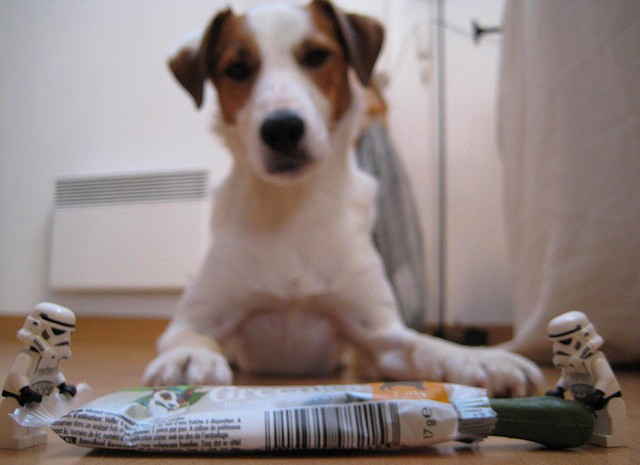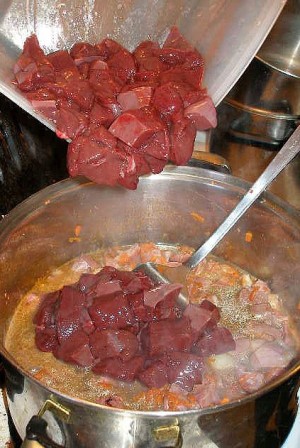

By T. J. Dunn, Jr., DVM
Pet nutrition principles for feeding dogs continue to evolve. An example of how far we've come concerns what we veterinarians, 30 years ago, used to call "All Meat Dogs." These pathetically sick and dying dogs were coming in to clinics all over the United States, thin, weak, with hair loss and metabolic imbalances as a direct result of eating a nationally advertised "All Meat" canned dog food.
Nearly everyone at that time thought that because dogs were carnivores (they're technically omnivores) that "all meat" diets must be the best thing for them! We know now that dogs cannot survive if fed 100% meat for extended periods.
Since then, pet food manufacturer's knowledge has changed and they now make some properly formulated foods. We've all learned much more about just what it takes to put together the right combination of ingredients in the proper ratios to create a nutritious diet. Unfortunately for the pet food purchaser, and worse for the dog, there are available all across the United States various brands of foods that, despite what the label may claim, are NOT a good source of nutrition for your dog. Some are actually harmful!
During my thirty years of veterinary practice I have often been upset by the poor condition I see some of my canine patients in due to inferior quality diets that the owner honestly believes to be adequate. In good faith the dog owner assumes that since the dog food label proclaims "complete and balanced", "premium", "high protein", and so on, that their dog will automatically do just great if that's all it is fed.
Because of ambiguous or deceptive labeling of the dog food, the owner unknowingly will feed an inadequate diet. And it may be decades before the FDA requires more strict guidelines for dog food manufacturers to follow so that misleading, ambiguous, and sometimes phony labeling practices no longer confuse or trick the purchaser.
For example, I could put together a "high protein" dog food where the protein is composed of an indigestible substance such as feathers, hide or hoofs. Sure, the protein level by analysis might be high (and even the experts don't agree as to just what amount qualifies as "high" protein level in a food) but if the dog's gastrointestinal tract is unable to break the protein molecules down into amino acids and then absorb and utilize those amino acids, the diet is worthless as a food source for the dog!
So "high protein" on the label means absolutely nothing; you've got to read the ingredients label to see if the source of protein is digestible.
See Table #1 to compare the approximate digestibility of the more common dog food ingredients. Egg white protein is used as the benchmark, giving it a value of one (1) since it is so highly digestible. Other protein sources are then compared to egg whites regarding their digestibility.
(Note: Values in table are approximate, as they have been taken from several nutrition sources and personal communications with nutrition experts.)
Egg whites 1.00 Muscle meats (chicken, beef, lamb) .92 Organ meats (kidney, liver, heart) .90 Milk, cheese .89 Fish .75 Soy .75 Rice .72 Oats .66 Yeast .63 Wheat .60 Corn .54
It's a good idea to explore the dog food label to see if the statement of its suitability is documented either by analysis or through feeding trials as specified by AAFCO (Association of American Feed Control Officials). You should have much greater confidence in the diet's nutritional value if feeding trials on live dogs have been done as opposed to the diet having been designed on paper only and, therefore, formulated by analysis.
Did you know that even if the dog food label says that the ingredients are X, Y, Z that there may not be any X or Y or Z in the food at all? How could this happen? The practice of substitution of one or more ingredients is a greater possibility if you buy that food from a small local mill or if the food is of a generic variety. Generally, the larger manufacturers have set ingredient parameters that don't vary. This is called a fixed formula.
On the other hand, some pet food producers will substitute ingredients and not change the label to truthfully reflect what you're buying. Price and availability of raw ingredients change from day to day, the less ethical producer will then substitute one ingredient for another in order to keep production costs to a minimum. They want to make that food as cheaply as possible! And changing the label to reflect the ingredient change is not required to be done immediately.
Did you know that some of the most popular and most trusted brands of dog foods are purposely formulated to just meet the minimum requirements of an average dog? These formulations are set up so that the pet food can be sold at a targeted lower price in order to appeal to the consumer group that will not spend higher amounts on dog food. A dog food that just barely meets the minimum nutritional requirements of a dog will have cheaper ingredients, such as grains, instead of higher quality ingredients that cost more. And meeting the minimum standards for an average dog means statistically some dogs won't get what they need.
What if your puppy or adult dog isn't average? No one has ever shown me what an average dog looks like so how am I, after working with tens of thousands of dogs over thirty years of practice, supposed to know the difference between an average dog and one that isn't? How will you know if your dog is average? And even if you did know, would you really want to feed it a food that was specifically designed to only meet it's minimum requirements?
Buy a cheap dog food and you will be feeding your dog cheap ingredients. Cheap ingredients are less efficiently digested, there's more fecal waste production, and the dog won't be as healthy as when fed higher quality (meat-based) dog food.
Another example of how poorly regulated the pet food industry is concerns preservatives. There are all kinds of agents used to keep the nutritional value in that bag or can of dog food from deteriorating over time. The AAFCO (Association of American Feed Control Officials) Official Publication lists 36 preservatives, some having no restrictions on amounts that can be mixed with the food. Chemicals such as Ethoxyquin and BHA (butylated hydroxyanisole) have controversial reputations as to safety. Most experts will tell us they are safe, however, many pet owners would rather avoid chemical preservatives and instead use substances that don't have murky reputations. Currently, pet food consumers have driven the popularity of more "natural" preservatives such as vitamin E or vitamin C.
Naturally we consumers, when given a choice, generally pick a food preserved with vitamin E and have every reason to expect that the food has no other preservatives in it. Well, sorry. It still could have other chemical preservatives in the food if the manufacturer purchased the fat and protein from suppliers who, prior to shipping to the manufacturers, added chemical preservatives. So the food manufacturer's label says, "preserved with Vitamin E" because that's all they added. You have no way of knowing if prior to what the manufacturer did, someone else added other preservatives. In my opinion, the pet food industry really needs tighter controls and more specific labeling of their products.
In the meantime, you might be asking, "How do I pick out a good food for my dog?" There are some general rules to follow and concepts to keep in mind when choosing a good dog food.
Making the right choice starts with reading the label's list of ingredients. By law the ingredients must be listed according to weight of the ingredient added in descending order. In other words, by weight of raw ingredient the main ingredient is listed first, second most prominent ingredient next, and so on.
The first three ingredients are the most important. It's easy to tell if the diet is vegetable based, with corn, rice, wheat, and soybean meal listed as the main ingredients; or if the diet is meat based, with meat, lamb, fish or poultry listed as the main ingredients.
I would always pick a meat-based diet over vegetable-based foods for optimum health for dogs. Now...here's the catch! I'm going to have to pay more for the meat-based diet! Responsible and caring dog owners should never let the price of the food dictate the purchase decision. In almost every situation with dog food, you get what you pay for. The higher the price the higher the quality. I'll let you consider the converse of that. And the higher the quality of the ingredients, the greater the nutritive value for the dog. Plus, you will purchase less high quality food than cheap food since dogs must eat more low quality food to meet their nutritional needs.
Immediately you will notice that when feeding a high quality, meat-based food, the dog will need to consume fewer cups of it per day than a cheap diet; the dog will also pass noticeably less stool when consuming a high quality diet than with a grain-based diet.
Cheap dog foods -- and they are widely available and wrapped in all sorts of fancy labels -- will contain cheap ingredients that will be poorly digested and will lead, over varying lengths of time, to deficiencies in your dog's health. Stroll through the pet food departments of various pet food outlets and read the labels of the different products. The cheap food will almost always be vegetable based and the more costly foods will be meat, poultry or fish based. Your dog has no control over your choice; so you have an obligation to provide good quality products that will optimize your dog's quality of life!
And don't forget to pay attention to the trick of "ingredient splitting." What the pet food manufacturer does, in order to make the ingredient list look better, is to break down a product such as corn into its different forms, then place each form of the ingredient into the ingredient list according to the amount of the form present.
For example, they will list ground corn, yellow corn meal, corn gluten, and corn gluten meal separately and thereby split up "corn" (which really should be listed as the main ingredient) in to places further down on the ingredient list to make it appear to the consumer that there is less corn in the dog food.
See the difference between meat-based diets and grain-based diets here.
This listing, required on dog food labels, is intended to instill confidence in the product's contents; however, it only gives you a percent approximation of what you are buying. It indicates maximum or minimum amounts of the substance in the food.
For example, if Crude Fiber is listed as "Not less than l0%", you have no idea how much over 10% is actually in the diet; or if Crude Fat "Not less than 15%" is listed, does the diet contain 16% or 36%? So the Guaranteed Analysis helps, but not much.
If dog owners had to choose one or the other, canned food or dry food, they should choose the dry. Canned food is generally 75% water, so 75% of your purchase price is going toward a non-nutritive ingredient that you can readily obtain from your own water faucet. Plus, there is an advantage to oral hygiene in the friction of the dry dog food, helping to keep the gums and teeth healthier than if the dog were eating only canned food.
The only time I recommend canned food is to someone who refuses to stop buying cheap dry food; the addition of canned food to a cheap dry food will generally improve the total diet. And just like the dry food, canned food has an ingredient list you can read to help guide your purchase decision. A dog being fed a high quality dry food does not require any canned food.
I never recommend semi-moist foods. You know the ones ... they're wrapped in cellophane and look like meat and have names that give the impression they're meaty. I often wonder why the manufacturers, if they want to associate these foods with meat, don't put any meat in them! They do put lots of food coloring, soybean meal, sucrose and preservatives like propylene glycol in them, though! Forget about the semi-moist dog foods.
Many of my clients, when I query them about what they feed their dog, will proudly offer this statement, "... but we never feed table scraps!" And I respond, "Why not?" Dogs can be fed many foods that people eat, but there are exceptions -- such as the fact that some dogs are lactose intolerant, grapes on occasion can cause (kidney damage,) and overfeeding certain foods can create nutritional imbalances.
You, at home, could feed your dog a perfectly fine diet if you knew the right amounts of meats, vegetables, fruit, etc. to feed and in the proper ratios. But why bother when there are good diets already prepared for you by companies employing highly knowledgeable scientists with years of research backing them up?
Table scraps are perfectly acceptable to give to most dogs under certain conditions. And it is better to feed them to the dog than throw good food in the garbage. But you must remember that sudden changes in some dog's diet may promote diarrhea, vomiting and in the instance of providing too much fat all of a sudden, pancreatitis.
Most dogs eat more consistently, are less finicky, and are less likely to have digestive tract upsets if they are fed consistently every day. If you choose to feed table scraps, try to do it on a fairly consistent basis.
I am not a proponent of feeding bones to dogs. For one thing there is almost no food value in bones (although there is plenty of good nutrition in the attached muscle and fat). Don't believe me? Take a look for yourself to see just how little food value there is in bones.
I've actually had clients brag to me how their dog "Eats 'em right up." As dogs chew on them, animal bones are apt to splinter and if the dog swallows them, the dog may get into a situation requiring surgery to save its life. I have surgically removed bones and bone fragments from dog's anatomy ranging from bones caught between the upper molars in the mouth to razor-like fragments from a lacerated rectum. Many dogs have died as a direct result of eating bones; if you feed your dog any kind of animal bones, you're asking for trouble. Besides, there's very little nutritive value to bones, they are NOT quickly digested by stomach acids, and there are infinitely better ways to keep your dog's teeth clean!
For more info about this controversial topic, see some (actual cases) of bone obstruction here.
Here are a few notes relative to "table scraps" or "people food":
Dogs do not get worms from drinking milk! Loose stool is fairly common, though, due to the dog's inability to break down lactose which is milk sugar.
Dogs do not get worms from eating candy. Chocolate, because it contains a caffeine-like chemical called theobromine, in large amounts can cause heart problems and other potentially dangerous effects.
Garlic is not an effective de-worming substance; there are much more effective wormers available. Scientific studies have recently proven that neither yeast nor garlic will repel fleas.
Spaying (ovariohysterectomy) female and (neutering) (castrating) male dogs does not cause them to "get fat". In healthy dogs that are overweight the only reason they are overweight is that they are consuming more calories than they are burning up. Simply put ... somebody's feeding the dog too much!
"Hard bones are okay to feed, but never soft ones like chicken or turkey bones." FORGET IT! NO bones of any kind, ever, if you want to avoid the chance ofobstructive digestive tract disorders.
Dogs manufacture their own vitamin C internally so it is not required in the diet. You can safely give dogs vitamin C, but please don't believe all the stories about it curing hip dysplasia, arthritis, cancer, fleas, mange, cataracts, diabetes, allergies, etc. Dogs under stress of intense exercise, disease or aging may benefit from some supplementation.
Vitamin/mineral supplements for 99.9% of dogs are not required if the dog is on a high quality diet.In fact, providing extra calcium to large dogs on a proper diet will do harm. It is incorrect to give extra calcium just because "it's growing up so fast."
Dogs frequently develop allergies to corn, wheat, soy and other foods. Allergies are manifested usually by dry, itchy skin; reddened, swollen ears; itchy face and chin; compulsive licking of the paws. (Caution! These signs also are present when a dog has sarcoptic mites, so these parasites must be considered in any dog that seems to have a food allergy.) Vomiting and or diarrhea, meanwhile, may result if the dog develops food intolerances. Food allergies and intolerances can be a challenge for the veterinarian to properly diagnose.
Dietary deficiencies may take months to develop. I've seen dogs eating poor diets where it took 6 months before deficiencies became evident. Start feeding a high quality diet and you will see improvement in three weeks.
Many types of dermatological problems are avoided if the dog or cat is consuming an optimum diet. In some cases, adding a supplement such as an omega fatty acid is the key factor in avoiding repeated episodes of hot spots and other skin afflictions. If your dog or cat seems to lack good coat and skin health, consider upgrading the diet to a meat-based ingredient formula and adding a dietary supplement.
Every bag of dog food will give a suggested amount to feed relative to your dog's weight or breed. I'll give you a helpful hint... don't even bother to look at these suggestions. They'll only confuse you since they are imprecise and vague.
Keep in mind that every dog is unique (no wonder I can't find an "average" dog!) in it's metabolic rate (how fast it burns up calories) and nutritional requirements. Whether you feed "free choice" by keeping some food in the bowl all the time or "restricted" or "portion controlled" by feeding a certain amount once or twice a day, the very best way to judge if you are feeding the right amount is to look at the dog. If it appears too thin for its breed (remember, some breeds such as Setters and sight-hounds are normally "thin") then feed the dog more food. If the dog or puppy appears overweight, cut back on the amount fed.
Most dogs, probably 75%, if fed "free choice" will maintain optimum weight. The rest will become overweight and you, having complete control over what your dog consumes, will have to restrict the total amount of food intake to get that overweight dog back to a weight where it appears normal. To learn about weight loss, click here.
So the amount to feed varies with every dog. For example, you could have two dogs, each weighing 40 pounds, where one might require twice as much food as the other to maintain its weight at 40 pounds. So don't look at the food label to tell you how much to feed, look at the dog!
Strange to say but I believe we dog lovers will be going back to the future in properly feeding our canine friends. Going back to Nature by feeding meat-based foods and including what we term "table scraps" in dogs' diets will surely be an improvement over some of the grain-based, cheap pet foods available today. Raw diets, frozen meat diets and home made diets are here today and will be even more popular in the future because dog owners will see the excellent results these more natural diets achieve.
This is NOT to say that commercial canned and dry foods are not good for dogs and cats, either. I have personally examined 20 year old dogs and cats that we never fed table scraps but were fed only a brand name dry or canned food. There will always be a deserved place for commercial dry and canned pet foods; I just hope that the high quality ones are most utilized.
Use common sense. Read the labels. If you do those two things, you will certainly avoid the cheap, plant-based dog foods with the fancy labels that try to make you think you're getting a good deal.
Remember ... your dog's health, more than any other single aspect, depends upon optimum nutrition.
Image: Amy / via Flickr
 Making Ends Meet While Eating Healthy - You and Your Dog!
Fitting everything into a tight budget can
Making Ends Meet While Eating Healthy - You and Your Dog!
Fitting everything into a tight budget can
 O Christmas Tree: Decorating for the Winter Holidays When You Have Pets
Winter holidays are especially exciting, with all
O Christmas Tree: Decorating for the Winter Holidays When You Have Pets
Winter holidays are especially exciting, with all
 Small Intestinal Bacterial Overgrowth (SIBO) and Pancreatic Insufficiency
When a dog or cat is afflicted with exocrine pancr
Small Intestinal Bacterial Overgrowth (SIBO) and Pancreatic Insufficiency
When a dog or cat is afflicted with exocrine pancr
 Does Your Dog Smell Like… Dog?
Anyone who has lived with a dog knows that dogs smell. They
Does Your Dog Smell Like… Dog?
Anyone who has lived with a dog knows that dogs smell. They
 Understanding Common Pet Food Ingredients
Generally speaking, most pet foods contain a combi
Understanding Common Pet Food Ingredients
Generally speaking, most pet foods contain a combi
Copyright © 2005-2016 Pet Information All Rights Reserved
Contact us: www162date@outlook.com